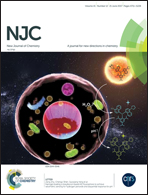Mechanism of Zn(OTf)2 catalyzed hydroamination–hydrogenation of alkynes with amines: insight from theory†
Abstract
The mechanism of Zn(OTf)2 catalyzed hydroamination–hydrogenation of alkynes with amines is investigated through density functional theory methods, and compared with the mechanism of hydroamination–hydrogenation reactions catalyzed by other late transition metals. Both the inner sphere and outer sphere mechanisms for the nucleophilic attack of nitrogen on the electrophilic alkyne centre to deliver imine have been investigated for a hydroamination reaction. Four different possibilities of hydrogen activation for the hydrogenation of imine to deliver amine have also been studied. These competitive reactions differ regarding the fate of the proton and hydride generated from the heterolytic cleavage of H2. The inner sphere mechanism is kinetically more demanding and not believed to contribute significantly to the progress of the reaction under the experimental conditions. The outer sphere route for the nucleophilic attack of the non-coordinated amine on the coordinated alkyne was found to be most plausible. The overall energy barrier for the outer sphere mechanism in the amine adduct can also be surpassed under the reaction conditions; therefore, this mechanism cannot be excluded safely. For the hydrogenation reaction, the heterolytic hydrogen cleavage involving proton shift on the triflate ligand and hydride to metal was found to be most plausible over the competitive H2 cleavage reactions involving hydrogenation through the dihydride route, and heterolytic H2 cleavage in which the proton shifts towards the ligand and the hydride shifts towards the electrophilic centre. However, the heterolytic hydrogen cleavage involving proton shift to the nitrogen and the hydride towards the metal also cannot be excluded safely. The kinetic barriers associated with the outer sphere mechanism of hydroamination (0.82 kcal mol−1) followed by the heterolytic hydrogen cleavage (33.84 kcal mol−1) mechanism are consistent with the experimental conditions (at 120 °C), suggesting that the mechanism is more plausible under experimental reaction conditions.



 Please wait while we load your content...
Please wait while we load your content...